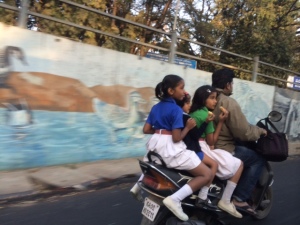
Years ago, I was fascinated reading research done by a Dutch traffic engineer named Hans Monderman. He theorized that the visual cues traffic engineers provide on roadways – stoplights, speed limit signs, directional arrows, curb markings and crosswalks – actually distract a driver’s attention and result in more accidents, rather than fewer. A test of his theory in the Dutch town of Drachten, resulted in surprisingly positive results in terms of reduction of accidents.
I thought of Monderman as I was navigating the roadways of Delhi last week with some fellow Adobe colleagues as we drove to our office in Noida. There is, quite simply, nothing that compares with driving in Delhi (unless, perhaps, it is driving in Bangalore). The reason Monderman came to mind was because his theory has unofficially been implemented in Delhi. It’s not that city authorities have removed all traffic symbols and markings, but rather that the drivers here just ignore them.
It’s a challenge to adequately describe driving in Delhi. Visualize six lanes of traffic filled with ubiquitous green and yellow tuk-tuks, entry-level Tatas, high-end Audis and Jaguars, and countless low-powered (150cc) motorcycles, each carrying three to five passengers – all of them are moving at 40 mph and weaving about to avoid each other, as well as stray dogs and cattle. Then, imagine a number of these vehicles randomly coming at you head on, only to veer off a moment before impact. It’s an adult version of Mr. Toad’s Wild Ride. Traffic lights and lane markers here are viewed as suggestive rather than mandatory. The air is filled with a cacophony of horns. Drivers “beep” constantly – not out of anger, but rather to communicate “I’m next to you. Please don’t hit me.”
The most courageous bicyclist in the world? That would be the elderly man mounted on a 1960s era bicycle, loaded with bundles of goods. He wove through six lanes of traffic without even glancing at the onrushing cars. It was as if he was trapped in a human Pac-Man game.
Interwoven with moments of absolute terror as we drove to the office were a number of thoughts. First, no teenage driver (anywhere in the world) should be permitted to receive a driver’s license unless they have demonstrated the ability to navigate across Delhi during rush hour without accident. I’m convinced that the cost of transporting new drivers to Delhi could be more than offset by the reduction in insurance claims.
Second, race car drivers should be recruited from the streets of Delhi. The drivers here are fearless and accustomed to driving safely at speed with only inches separating them from other vehicles.
Also, a note to the folks at Google – test your driverless car here. If it can handle the computational variables presented by the Delhi streets, it will work anywhere.
As we approached Noida, we passed a large sign designating the “Institute of Driving and Traffic Research” – a prominent area adjacent to the highway with artificial roadways and traffic lights. I’m going to go out on a limb here and suggest that this is an area of India government that needs a tad bit more funding.
The Adobe team in India is impressive. Smart, engaged, hard-working and innovative. Many of them have worked for the company for over fifteen years. But, one of the things I find most striking about our employees is that they manage this commute each day. Without doubt, if any of them decide to give up a career in tech, the NASCAR circuit will welcome them with open arms.


As always your my Hero!